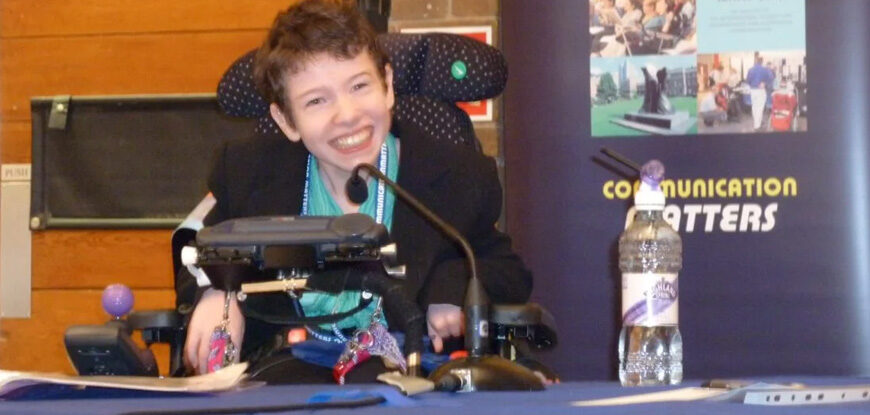I’ve been creating & delivering presentations using AAC with groups and at conferences since I was 12. Along the road I’ve learned loads from observing other presenters. In addition I’ve doing my own research on what makes a good presentation. After every session I always reflect on how it went and what I might improve or change for the next time.
 Remember you will need extra time to get your message across when using AAC to present
Remember you will need extra time to get your message across when using AAC to present
My advice is to ensure you have enough time allocated to deliver your message. I had written into my University support plan that I needed 100% extra time to present and double the number of slides allocated to other students. For instance if another student is given 5 minutes to present 5 slides I get 10 minutes and 10 slides.
 The rationale for extra time and slides is that natural speech is around 160-180wpm (and faster if the presenter is nervous), so in 5 minutes others would deliver around 800 words of content. As pre-programmed speech is output from my device at 80-100 words per minute I need extra time to deliver a similar level of content, work my tech and the extra slides to ensure engagement with the audience. This wasn’t a difficult ask as I already got 100% extra time for my coursework. In group presentations the lecturers always made sure other students understood this extra time, and the supplementary slides, could only be used by me.
The rationale for extra time and slides is that natural speech is around 160-180wpm (and faster if the presenter is nervous), so in 5 minutes others would deliver around 800 words of content. As pre-programmed speech is output from my device at 80-100 words per minute I need extra time to deliver a similar level of content, work my tech and the extra slides to ensure engagement with the audience. This wasn’t a difficult ask as I already got 100% extra time for my coursework. In group presentations the lecturers always made sure other students understood this extra time, and the supplementary slides, could only be used by me.
Planning and preparing a presentation
Each of us is different and there is no right or wrong way to plan and prepare for a presentation. As a visual thinker I see the presentation and its flow in my mind. So the logical way if for me to prepare first a PowerPoint presentation and then add the words I’m going to deliver afterwards. Other people might want to prepare the words and then use a PowerPoint to emphasis the points they are making.
Considerations for AAC users
Being an AAC speaker brings some additional challenges to consider and prepare for. Here are a few things I take into consideration when planning:

Planning for a Q&A
Having a live question and answer session can be both daunting, and can take a lot of time if you are spontaneously responding to questions from your audience. Here are a few techniques I’ve used to try and address this.

Considering your visual content to complement your spoken words
I always want my presentations to engage my audience as fully as possible. As a visual learner and thinker then I like to use PowerPoint to support what I’m saying. The added benefit is adding some videos or music allows me to break things up a bit. When someone is not used to listening to an electronic voice they can find the cognitive load quite high, especially if the rate of delivery is too fast.
Here are some of the things I think about when preparing a PowerPoint and visual support.

Find ways to relax when delivering your presentation
Finally, here are a few things I’ve picked up from observing other presenters from all walks of life. The very first time I presented I was very nervous. When I’m nervous then my body tightens and activating speech buttons and slides is harder. After discussing this with my Mum we can up with some visual imagery which makes me smile. I imagine as I look around the room my audience are all bobbing up and down in a swimming pool, wearing banana skin swimsuits. As there are usually some people I know who will be present I focus my visualizations on them. The images running through my head just make me smile, this makes me relax and then any ‘stiffness’ in my body which affects my gross and fine motor movements disappears.

One of the best things about using AAC is that whilst you might be nervous your voice will not have the nervous ‘wobble’ presenters using natural speech sometimes display.
 When, where and to who?
When, where and to who?
I’ve presented at family gatherings, in university, via webinars, to small groups and to packed conference halls with several hundred people.
The content has been diverse; sharing my lived experiences, an academic project, training for other AAC users, training around AAC for professionals and sometimes just about life. Mostly this has been on my own and sometimes in collaboration with others. You can find out more about my work here.
If you get the chance to present, give it a try
Each time I get the same thrill, as someone who relies on AAC and finding it challenging to sometimes be heard, then having the opportunity of sharing my work, thoughts and opinions with people who want to listen is empowering. Good luck to you with creating & delivering presentations using AAC.


If you found this interesting or
helpful please feel free to share.